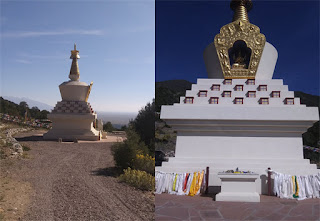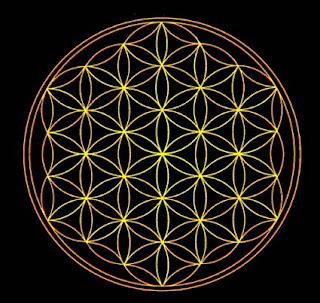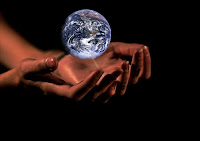Since moving to the spiritual mecca of Crestone, Colorado in March of 2020, my wife and I have made pilgrimages to many of the areas sacred sites. At 7,923 feet in elevation and located next to the Sangre de Cristo Mountains, Crestone is both beautiful and isolated, subject to extremes of weather, wind, and temperature. It includes an astonishing array of spiritual sites -- more than two dozen ashrams, monasteries, temples, retreat centers, stupas, shrines, labyrinths, and other sacred landmarks. Although pilgrimage may seem an antiquated religious ritual, it remains a vibrant activity in the modern world as pilgrims combine traditional motives -- such as seeking a remedy for physical or spiritual problems -- with contemporary searches for identity or interpersonal connection.
Our most recent pilgrimage was to the Tashi Gomang Stupa, located about two miles by trail from our home. Since the time of the Buddha's (566-485 BCE) death, Buddhists have constructed stupas to contain the relics of enlightened teachers. Stupas have become places of veneration and pilgrimage in Buddhist cultures throughout the world. A stupa is an architectural rendering of the Buddhist path, the stages and aspects of enlightenment. When a great Buddhist teacher leaves his or her physical existence, the body that remains is considered to be permeated with the very essence of awakened mind, possessing tremendous intrinsic power and blessings. The appropriate vessel for containing these relics is a stupa. Through its design and contents, a stupa is regarded as having the power to transmit the essence of awakened mind, on the spot, to anyone ready to receive it.
Within the Tibetan tradition there are eight kinds of stupas representing eight major events in the life of the Buddha. The Tashi Gomang Stupa commemorates the Buddha's first teachings in Benares (Varanasi) when he expounded the Four Noble Truths and the Twelve Links of Interdependence. These teachings reveal the truth of suffering, the cause of suffering and the skillful means to bring about the cessation of suffering (enlightenment).
The stupa itself is completely enclosed and contains many special objects inside. A depository of offerings was placed underneath it in tribute to the goddess of the earth and local deities. It was considered essential to ask their permission before construction could take place. The base, or throne of the stupa was filled with juniper which has special powers of purification. Treasure vases were placed in the juniper along with musical instruments, medicines, herbs, food, precious jewels, silks, brocades, perfumes, gold, and silver. Through the blessings of the stupa, these substances will work to bring good health, harmony, peace, and prosperity to its surroundings.
The stupa has been filled with 100,000 tsa-tsas (or miniature stupas) made by volunteers. Within each tsa-tsa is a roll of prayers, and mantras. The tsa-tsas were blessed and consecrated by visiting lamas before being placed inside the stupa. Also inside the stupa are earth, water, and stone from the eight great pilgrimage sites in India; wood from the Bodhi tree under which the Buddha attained enlightenment, water from a cave of Milarepa, and other sacred objects.
The tsok-shing or "life force" pole was placed in the center of the bell-shaped body of the stupa and reaches to the top of the spire. It was carved from a juniper tree into the shape of an obelisk, with a half dorje (vajra - thunderbolt) at the bottom and a small stupa at the top. Precious relics were placed in the life-force pole and then it was painted, inscribed in gold with the Buddha's teachings, and wrapped in silks and brocades. It rests on two mandalas, also covered with offerings.
The statue of His Holiness the 16th Karmapa, wearing his Black Crown, was placed at the front of the stupa. Artisans in Nepal made the statue and its encasing niche and frame, as well as the ornamentation on top of the spire. The gold leaf finish and additional ornamentation was done on site in Baca Grande. Inside the statue is another tsok-shing, rolls of mantras, and relics from all sixteen Karmapas and other saints.
The Tashi Gomang Stupa embodies His Holiness the 16th Gyalwa Karmapa. In the words of H.H. Dilgo Khyentse Rinpoche: "Within the stupa the teacher remains unchanging. The Buddha said that whoever sees the stupa will be liberated by the sight of it. Feeling the breeze around the stupa liberates by its touch. Having thus seen or experienced the stupa, by thinking of one's experience of it, one is liberated through recollection. As our world increasingly adopts a secular and atheistic perspective in many domains of experience, pilgrimage, for many like myself, remains a potent force.




















